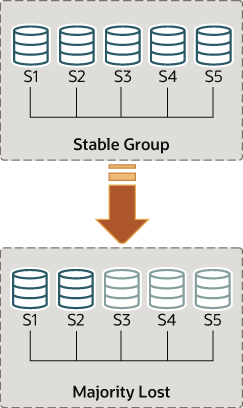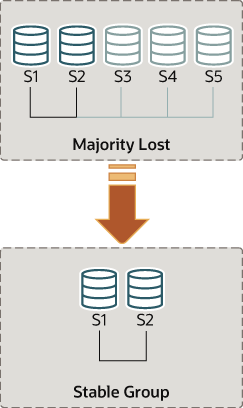The group needs to achieve consensus whenever a change that needs to be replicated happens. This is the case for regular transactions but is also required for group membership changes and some internal messaging that keeps the group consistent. Consensus requires a majority of group members to agree on a given decision. When a majority of group members is lost, the group is unable to progress and blocks because it cannot secure majority or quorum.
Quorum may be lost when there are multiple involuntary failures, causing a majority of servers to be removed abruptly from the group. For example, in a group of 5 servers, if 3 of them become silent at once, the majority is compromised and thus no quorum can be achieved. In fact, the remaining two are not able to tell if the other 3 servers have crashed or whether a network partition has isolated these 2 alone and therefore the group cannot be reconfigured automatically.
On the other hand, if servers exit the group voluntarily, they instruct the group that it should reconfigure itself. In practice, this means that a server that is leaving tells others that it is going away. This means that other members can reconfigure the group properly, the consistency of the membership is maintained and the majority is recalculated. For example, in the above scenario of 5 servers where 3 leave at once, if the 3 leaving servers warn the group that they are leaving, one by one, then the membership is able to adjust itself from 5 to 2, and at the same time, securing quorum while that happens.
Loss of quorum is by itself a side-effect of bad planning. Plan the group size for the number of expected failures (regardless whether they are consecutive, happen all at once or are sporadic).
For a group in single-primary mode, the primary might have
transactions that are not yet present on other members at the time
of the network partition. If you are considering excluding the
primary from the new group, be aware that such transactions might
be lost. A member with extra transactions cannot rejoin the group,
and the attempt results in an error with the message
This member has more executed transactions than those
present in the group. Set the
group_replication_unreachable_majority_timeout
system variable for the group members to avoid this situation.
The following sections explain what to do if the system partitions in such a way that no quorum is automatically achieved by the servers in the group.
The replication_group_members
performance schema table presents the status of each server in
the current view from the perspective of this server. The
majority of the time the system does not run into partitioning,
and therefore the table shows information that is consistent
across all servers in the group. In other words, the status of
each server on this table is agreed by all in the current view.
However, if there is network partitioning, and quorum is lost,
then the table shows the status UNREACHABLE
for those servers that it cannot contact. This information is
exported by the local failure detector built into Group
Replication.
To understand this type of network partition the following section describes a scenario where there are initially 5 servers working together correctly, and the changes that then happen to the group once only 2 servers are online. The scenario is depicted in the figure.
As such, lets assume that there is a group with these 5 servers in it:
Server s1 with member identifier
199b2df7-4aaf-11e6-bb16-28b2bd168d07Server s2 with member identifier
199bb88e-4aaf-11e6-babe-28b2bd168d07Server s3 with member identifier
1999b9fb-4aaf-11e6-bb54-28b2bd168d07Server s4 with member identifier
19ab72fc-4aaf-11e6-bb51-28b2bd168d07Server s5 with member identifier
19b33846-4aaf-11e6-ba81-28b2bd168d07
Initially the group is running fine and the servers are happily
communicating with each other. You can verify this by logging
into s1 and looking at its
replication_group_members
performance schema table. For example:
mysql> SELECT MEMBER_ID,MEMBER_STATE, MEMBER_ROLE FROM performance_schema.replication_group_members;
+--------------------------------------+--------------+-------------+
| MEMBER_ID | MEMBER_STATE | MEMBER_ROLE |
+--------------------------------------+--------------+-------------+
| 1999b9fb-4aaf-11e6-bb54-28b2bd168d07 | ONLINE | SECONDARY |
| 199b2df7-4aaf-11e6-bb16-28b2bd168d07 | ONLINE | PRIMARY |
| 199bb88e-4aaf-11e6-babe-28b2bd168d07 | ONLINE | SECONDARY |
| 19ab72fc-4aaf-11e6-bb51-28b2bd168d07 | ONLINE | SECONDARY |
| 19b33846-4aaf-11e6-ba81-28b2bd168d07 | ONLINE | SECONDARY |
+--------------------------------------+--------------+-------------+
However, moments later there is a catastrophic failure and
servers s3, s4 and s5 stop unexpectedly. A few seconds after
this, looking again at the
replication_group_members table on
s1 shows that it is still online, but several others members are
not. In fact, as seen below they are marked as
UNREACHABLE. Moreover, the system could not
reconfigure itself to change the membership, because the
majority has been lost.
mysql> SELECT MEMBER_ID,MEMBER_STATE FROM performance_schema.replication_group_members;
+--------------------------------------+--------------+
| MEMBER_ID | MEMBER_STATE |
+--------------------------------------+--------------+
| 1999b9fb-4aaf-11e6-bb54-28b2bd168d07 | UNREACHABLE |
| 199b2df7-4aaf-11e6-bb16-28b2bd168d07 | ONLINE |
| 199bb88e-4aaf-11e6-babe-28b2bd168d07 | ONLINE |
| 19ab72fc-4aaf-11e6-bb51-28b2bd168d07 | UNREACHABLE |
| 19b33846-4aaf-11e6-ba81-28b2bd168d07 | UNREACHABLE |
+--------------------------------------+--------------+The table shows that s1 is now in a group that has no means of progressing without external intervention, because a majority of the servers are unreachable. In this particular case, the group membership list needs to be reset to allow the system to proceed, which is explained in this section. Alternatively, you could also choose to stop Group Replication on s1 and s2 (or stop completely s1 and s2), figure out what happened with s3, s4 and s5 and then restart Group Replication (or the servers).
Group replication enables you to reset the group membership list
by forcing a specific configuration. For instance in the case
above, where s1 and s2 are the only servers online, you could
choose to force a membership configuration consisting of only s1
and s2. This requires checking some information about s1 and s2
and then using the
group_replication_force_members
variable.
Suppose that you are back in the situation where s1 and s2 are the only servers left in the group. Servers s3, s4 and s5 have left the group unexpectedly. To make servers s1 and s2 continue, you want to force a membership configuration that contains only s1 and s2.
This procedure uses
group_replication_force_members
and should be considered a last resort remedy. It
must be used with extreme care and only
for overriding loss of quorum. If misused, it could create an
artificial split-brain scenario or block the entire system
altogether.
When forcing a new membership configuration, make sure that any servers are going to be forced out of the group are indeed stopped. In the scenario depicted above, if s3, s4 and s5 are not really unreachable but instead are online, they may have formed their own functional partition (they are 3 out of 5, hence they have the majority). In that case, forcing a group membership list with s1 and s2 could create an artificial split-brain situation. Therefore it is important before forcing a new membership configuration to ensure that the servers to be excluded are indeed shut down and if they are not, shut them down before proceeding.
For a group in single-primary mode, the primary might have
transactions that are not yet present on other members at the
time of the network partition. If you are considering
excluding the primary from the new group, be aware that such
transactions might be lost. A member with extra transactions
cannot rejoin the group, and the attempt results in an error
with the message This member has more executed
transactions than those present in the group. Set
the
group_replication_unreachable_majority_timeout
system variable for the group members to avoid this situation.
Recall that the system is blocked and the current configuration is the following (as perceived by the local failure detector on s1):
mysql> SELECT MEMBER_ID,MEMBER_STATE FROM performance_schema.replication_group_members;
+--------------------------------------+--------------+
| MEMBER_ID | MEMBER_STATE |
+--------------------------------------+--------------+
| 1999b9fb-4aaf-11e6-bb54-28b2bd168d07 | UNREACHABLE |
| 199b2df7-4aaf-11e6-bb16-28b2bd168d07 | ONLINE |
| 199bb88e-4aaf-11e6-babe-28b2bd168d07 | ONLINE |
| 19ab72fc-4aaf-11e6-bb51-28b2bd168d07 | UNREACHABLE |
| 19b33846-4aaf-11e6-ba81-28b2bd168d07 | UNREACHABLE |
+--------------------------------------+--------------+The first thing to do is to check what is the local address (group communication identifier) for s1 and s2. Log in to s1 and s2 and get that information as follows.
mysql> SELECT @@group_replication_local_address;
Once you know the group communication addresses of s1
(127.0.0.1:10000) and s2
(127.0.0.1:10001), you can use that on one of
the two servers to inject a new membership configuration, thus
overriding the existing one that has lost quorum. To do that on
s1:
mysql> SET GLOBAL group_replication_force_members="127.0.0.1:10000,127.0.0.1:10001";
This unblocks the group by forcing a different configuration.
Check replication_group_members on
both s1 and s2 to verify the group membership after this change.
First on s1.
mysql> SELECT MEMBER_ID,MEMBER_STATE FROM performance_schema.replication_group_members;
+--------------------------------------+--------------+
| MEMBER_ID | MEMBER_STATE |
+--------------------------------------+--------------+
| b5ffe505-4ab6-11e6-b04b-28b2bd168d07 | ONLINE |
| b60907e7-4ab6-11e6-afb7-28b2bd168d07 | ONLINE |
+--------------------------------------+--------------+And then on s2.
mysql> SELECT * FROM performance_schema.replication_group_members;
+--------------------------------------+--------------+
| MEMBER_ID | MEMBER_STATE |
+--------------------------------------+--------------+
| b5ffe505-4ab6-11e6-b04b-28b2bd168d07 | ONLINE |
| b60907e7-4ab6-11e6-afb7-28b2bd168d07 | ONLINE |
+--------------------------------------+--------------+
After you have used the
group_replication_force_members
system variable to successfully force a new group membership and
unblock the group, ensure that you clear the system variable.
group_replication_force_members
must be empty in order to issue a START
GROUP_REPLICATION statement.

